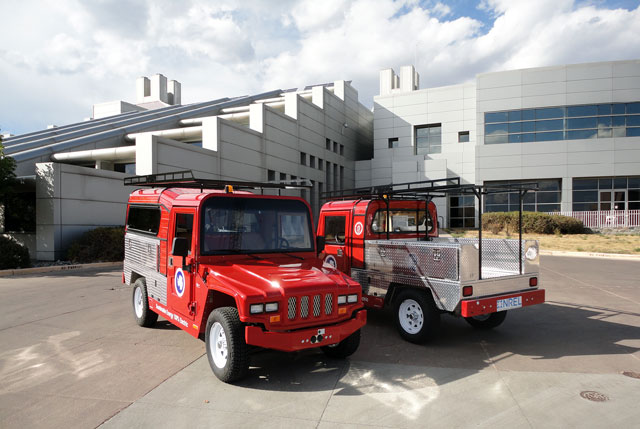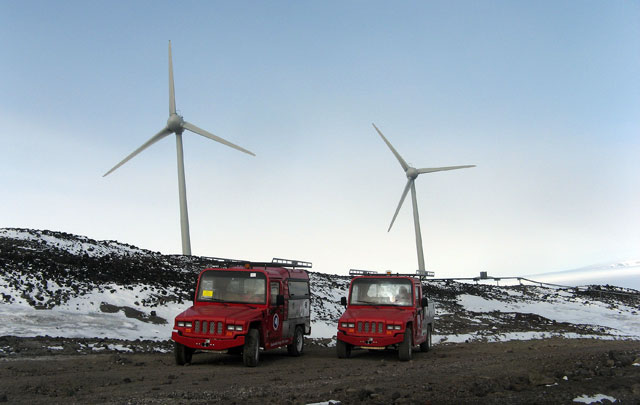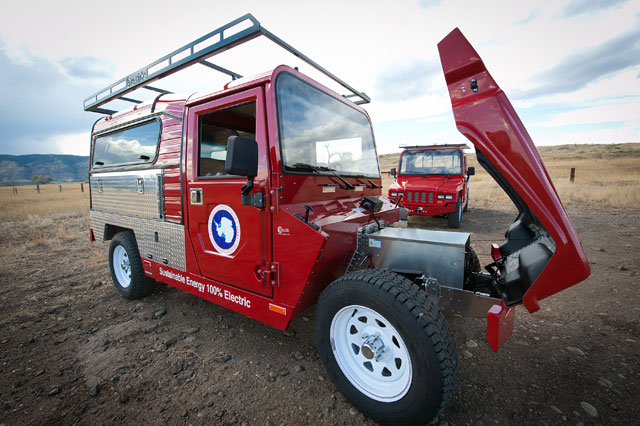|
Plugged inUSAP tests electric vehicles during winter in AntarcticaPosted May 13, 2011
Antarctica is a natural laboratory that draws hundreds of scientists down to the southern hemisphere each year to conduct research on everything from climate change to penguins and whales to astrophysics. However, an experiment under way this winter falls a bit outside the norm. The National Science Foundation (NSF) A pair of lightweight utility vehicles manufactured by e-ride Industries arrived at the U.S. Antarctic Program’s McMurdo Station Each electric vehicle has a cab for two people with larger utility-style tires for use on dirt roads, with one sporting an enclosed rear bed and the other an open flatbed. Its maximum speed is 25 miles per hour, with a max load of about 1,000 pounds. They were outfitted with insulation for the batteries and battery heaters, with one also carrying a data logger that records a variety of information, such as speed, distance, battery charge and even outside temperature. The base price for each vehicle was about $17,000. If successful, a future generation of a similar electric vehicle might replace much of the station’s truck fleet, if the NSF decides to make the investment, according to Kent Colby, McMurdo’s technical projects manager for Raytheon Polar Services Company (RPSC) “Eighty percent of their usage is just short hops around town,” Colby said. “I could see that they could replace a good amount of the in-town vehicle usage because every time you look at a pickup in town, you have one, maybe two people in it with one, maybe two tool bags.” DOE’s National Renewable Energy Laboratory (NREL) “The idea is that these types of vehicles could be used in other cold-weather programs and NSF sites, such as Summit Station Some of the initial testing was conducted at NREL’s facility using a cold cell where the temperature was dropped down to minus 9 degrees Fahrenheit while the vehicles were on a dynamometer, a device that measures the engine’s power and torque. On the Ice, the vehicles have performed as expected, climbing the steepest hills on a full charge. However, as winter settles in, the charge only lasts about an hour-and-a-half, Colby said, though he added that may be due to operators not plugging in the battery warmers. “Keeping the batteries warm is more critical than keeping them charged,” he said. Noted Sears, “They have limitations. The cold really saps the battery.” But added: “It sounds like to me there are many opportunities for using these.” The vehicles are also an attractive alternative thanks to the low maintenance required on the electric engines, according to Colby. “Basically, their maintenance schedule is once-a-year lubrication,” he said. The electric vehicles represent the latest efforts by the USAP to lighten its carbon footprint in the Antarctic. In recent years, more and more field camps sport solar panels and small wind turbines versus diesel generators. Antarctica New Zealand Even when it must rely on fossil fuel, the program has made strides in being more efficient. Its new power plant diesel engines return 33 percent of the fuel’s energy as electricity, according to George Blaisdell, operations manager in NSF’s Office of Polar Programs The system is able to capture much of the remaining energy as waste heat to warm many of the station’s buildings. “At McMurdo, we capture a total of 85 percent as useful energy; at the South Pole, we believe we are closer to 95 percent,” Blaisdell said in the interview. He estimated that McMurdo’s light-vehicle fleet only gets back 10 to 15 percent of the fuel’s “energy content.” “With an electric truck, the power comes from batteries that are charged by our power plant, which is harvesting eight times as much energy from our fuel as the internal-combustion engine does,” he said. “For light electric vehicles, McMurdo’s environment is ideal.”
|



For USAP Participants |
For The Public |
For Researchers and EducatorsContact UsU.S. National Science FoundationOffice of Polar Programs Geosciences Directorate 2415 Eisenhower Avenue, Suite W7100 Alexandria, VA 22314 Sign up for the NSF Office of Polar Programs newsletter and events. Feedback Form |





